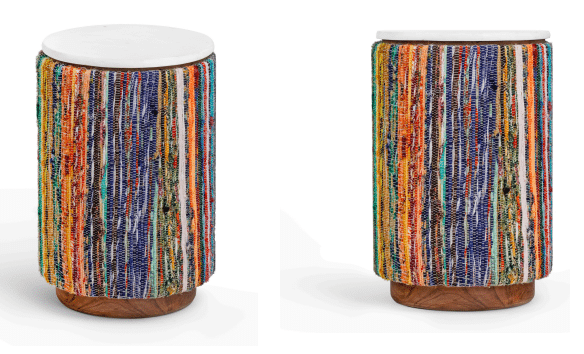Since time immemorial, Indian households have repurposed every last piece of time worn clothing that they could lay their hands on. Yes, Indian women and their passion for up-cycling leftovers create wonders in our beautiful nation. From innovative new dishes and colourful fashion accessories to astounding space rockets – there is nothing that the mysterious minds of these creative ladies cannot conceive. Anyone who has viewed Mission Mangal knows that India is a nation that can even reach the crimson sands of Mars solely on the wings of ingeniously repurposed material!
Today, when the world is scrambling towards sustainability to ensure a better tomorrow for future generations, the ideas of these thrifty ladies are a sight for sore eyes! One such fascinating craft envisioned by their prolific brains is the traditional Chindi Craft. This mesmerising technique not only gives true
meaning to the phrase “one man’s trash is another man’s treasure”, but also serves as a lifeline for countless rural women, weaving economic
empowerment within its colourful patterns. As we embrace a future where sustainability is paramount, the ancient wisdom of chindi craft offers a vibrant path forward.
The creation of chindi fabric begins with a meticulous selection process. Artisans, often women from underprivileged backgrounds, carefully sort through piles of waste fabric scraps, commonly known as “katran”. These scraps may range from brightly – hued soft cottons to more muted synthetic blends, each bringing a unique character to the piece. Each scrap is evaluated for its colour, texture, and durability. Like a painter choosing a palette for their artwork, these skilled craftswomen select scraps culminating in the final design.
The chosen scraps are then placed above another fabric piece and everything is sewn together. As the seamstresses sew, a pattern emerges – sometimes planned, sometimes spontaneous – creating a unique composition of color and texture. Even though the process is labor – intensive and time – consuming, this investment of skill and time instills a distinctive character within each completed piece. This craft has recently been gaining traction all around the World; so much so that the Indian Government has astutely facilitated crafts people with the subsidised import of scrap cloth from around the globe.
Beauty lies in the eyes of the Beholder
At Studio Trataka, our designers embrace the disposables and render them durables. Our Chindi Table one such piece of sustainable home furniture is a testament to the art of upcycling that transforms fabric scraps into a functional work of art that captivates the eye and warms the heart. The white marble top and polished wooden base highlight the varied textures of its handwoven bodice, making the colours seem to glow from within as the natural light within a sun – drenched room plays across their surface.
Perhaps the most captivating aspect of this Bohemian side table is that every piece sings its own story of renewal through a unique mosaic of fabric with a mesmerizing combination of colors, patterns, and textures. The variations in the katran ensure that every table is a singular creation, demonstrating the beauty of unpredictability and the charm of handwoven furniture pieces. In essence, the Chindi table is not just a piece of furniture; it is a colorful manifesto for sustainable living, a celebration of Indian craft, and a daily reminder that beauty can be found in the most unexpected places – if only we have the vision to see it and the skill to bring it to life.
In contemporary times, the movement towards sustainability and ethical consumption has significantly contributed to the appeal of handmade products, celebrated for their superior quality and minimal environmental impact. Choosing sustainable products is not simply about saving a used dress from a landfill, but essentially about weaving a future where the Earth’s vibrant drapery is not threadbare. It is a logical leap that ripples outwards, creating a world where sustainability is not just a trend, but a timeless truth – akin to the glorious art pieces like the Chindi Table that we so lovingly create. As the human race turns its eyes to India’s example, we are reminded that sometimes, the most powerful solutions to global challenges can be found in the simplest traditions.
And in the grand canopy of Indian tradition, chindi craft is an unbreakable thread of ingenuity woven through the ages — a testament to the resourcefulness that defines our nation’s spirit. It shows us that with skill, imagination, and respect for our resources, we can create objects of beauty that honour both tradition and our planet; Masterpieces like our innovative Chindi Side Table – A Symbol of Rebirth that converts rags to riches. This unique table pays homage to the workmanship of Indian artisans, whose deft hands transform the mundane into the extraordinary; breathing new life into every scrap of discarded fabric.


